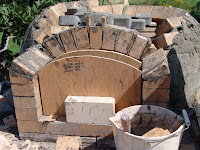 As stated in the previous posts, the throat will likely be the most challenging part of an oven project. Even on cob ovens (see previous blog), special attention is given to the mouth and, when desired, the throat.
As stated in the previous posts, the throat will likely be the most challenging part of an oven project. Even on cob ovens (see previous blog), special attention is given to the mouth and, when desired, the throat.What goes into the mouth as fuel should, after burning, pass into the throat and out, otherwise, as is true at fraternity parties, it will spew out of the mouth and mess up the face.
The first arch created the mouth. The second arch creates the throat.

 In this oven, the same form was bulked up with blocks so that the identical arch could be extended outward to support the bricks at this larger and higher dimension.
In this oven, the same form was bulked up with blocks so that the identical arch could be extended outward to support the bricks at this larger and higher dimension.Shims raise the form off the floor and a layer of cardboard makes removing the form after mortaring easy.

 Full length firebrick is cut to form corbels, a stepped-in series of bricks that take the wide opening of the throat and bring it to its intended 9" by 8" dimension.
Full length firebrick is cut to form corbels, a stepped-in series of bricks that take the wide opening of the throat and bring it to its intended 9" by 8" dimension.The next step in this oven will be constructing a flue channel that runs over the top of the oven so that the chimney, when installed, is set back from the face.













































